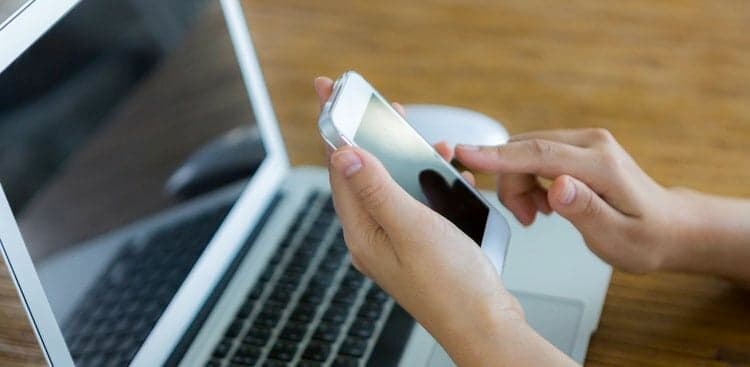A colleague of mine once compared phone and Skype interviews to take-home tests.
“You still need to study,” she explained. “But you can also have everything you need in front of you.”
If you’re wondering what exactly is “everything you need” and how you should you prepare your materials so it’s not totally obvious you’re shuffling through papers or reading over your notes, good news—we’ve got all the answers to help you properly prepare for your next remote interview.
In a Phone Interview
1. Your “Priority Points”
Before the interview, come up with a list of four or five key points you want to get across over the course of the interview. In other words, what should the hiring manager or recruiter absolutely know about you by the time you hang up the phone?
Right now, I’m applying for a lot of internships, so my priority points include how adaptable and flexible I am (which is important for an intern, whose tasks change every day), and how much editorial experience I have (which distinguishes me from other people my age).
This sheet should be smack dab in front of you while you take the call. You want to be able to glance down at it in the half-second pause you take before responding so you can incorporate what it says.
2. Your Resume
During one, uh, memorable interview, the woman asked which previous job I’d enjoyed the most—and I completely forgot every position I’d ever had. I sat there blinking for a good 30 seconds before finally saying something about how I’d enjoyed them all. Not good.
Now, I make sure my resume is always close by when I’m doing a phone interview. I print the exact copy with which I applied to make sure my answers don’t clash with anything on the resume the interviewer has. (If you’ve since been promoted or changed responsibilities, however, the resume you’re looking at should reflect that.)
I also highlight the roles that are the most similar to the job I’m interviewing for so I can emphasize them when answering questions about prior experience, challenges, learning moments, achievements, and so on.
Put your resume next to your priorities cheat sheet.
3. Your Cover Letter
There’s nothing worse than having an interviewer say, “So, in your cover letter you mentioned…” and having no idea what he or she is talking about. (No, this hasn’t happened to me, but it has happened to a friend!) When you’re job searching, you’re sending out tons of cover letters, and since we know you customize all of them (cough, cough), it’s easy to get the details mixed up. So it’s useful to have the one you sent to that company in front of you.
That being said, you want to use your cover letter as a reference—not a script. Don’t start reading it back to the interviewer, or you’ll sound robotic and give the interviewer no new information.
Place your cover letter slightly in front of you but off to the side. It’ll be easily accessible if you need it, yet not so close you’ll start regurgitating it in a moment of panic.
4. Your Questions
You know you’re supposed to say yes when hiring managers ask if you have any questions for them.
As one recruiter explains, “If an applicant doesn’t have any questions for me, that’s a red flag. I’m thinking that they either don’t care or can’t be bothered to do research about my company.”
(Not sure what to ask? Check out seven questions that will seriously impress hiring managers.)
To guarantee I ask the questions I want to ask, and not anything awful like, “How much will this job pay?”, I keep two or three Post-it notes close by with general topics.
For example, if I wanted to ask about a company’s professional development, I’d jot down “training/mentorship programs.” Keeping it broad means when the time comes, my questions will sound well-thought-out, but not scripted—and I can adapt them based on any conversation we’ve already had around the subject.
These Post-its can go at the top of your desk, because you won’t have to grab them until the end of the interview.
5. Headphones
I used to do phone interviews the “old-fashioned” way: using one hand to hold the phone up to my ear. That made it harder to grab my materials, so I switched to speaker-phone. Big mistake. The quality wasn’t great, and the interviewer kept saying, “What? What?” I ended up shouting phrases like, “I’M AN EXCELLENT PRIORITIZER!” and “I PRIDE MYSELF ON ALWAYS MEETING OR EXCEEDING MY DEADLINES!”
The solution? Microphone-enabled headphones. They’ll leave your hands free to access your notes and make raising your voice unnecessary.
On a Skype Interview
1. One Post-It Note
Skype interviews require you to be a lot choosier about what’s in front of you—the interviewer will definitely notice if your gaze is darting off-screen every 10 seconds.
For that reason, you should condense the things you most need to remember into one Post-it note. This won’t be easy, and it may require a couple draft notes before you finally get one you’re happy with.
It could include the skills you really want to highlight, your most impressive achievements, or even the reminder to smile!
Here’s the hack: If you put this Post-it on your computer screen right below the camera, the interviewer will never be able to tell you’re looking at a note and not his or her face.
2. Other Post-Its
If you absolutely can’t fit all the notes you need onto one sticky, you can place others around the border of your computer screen.
I’d be cautious about using too many. One time, I framed my entire screen in Post-its, and it was totally overwhelming—there was so much text in front of me I didn’t end up using any of them.
Or the opposite can happen: You don’t make eye contact with the interviewer because your eyes are ping-ponging all over the place.
For these reasons, I wouldn’t use more than three Post-its (including the one beneath the camera). And don’t cram them with as much info as possible; your writing should be big enough to read without difficulty.
3. A Notepad and Pen
At the end of the interview, when the roles are switched and you’re the one asking the questions, grab a notepad and a pen from an easy-to-reach place. (I usually put them off to the right of my laptop.)
Taking brief notes while your interviewer talks is a great way to show you’re engaged, you’re paying attention, and you genuinely care about the answers. Don’t go overboard—if you ask how much time employees spend together out of the office, and the hiring manager says, “We have a company-wide scavenger hunt at least once a month, and we go out to dinner a lot, and we have lots of fun clubs, and…” just write down, “social culture.”
The best part about having a notepad, however, is that before the interview you can fill the top half of the page with your questions.
It’ll appear as though you’re looking down to reference your notes, but you’ll actually be reminding yourself of the key things you want to ask.
4. Your Resume and Cover Letter
It's pretty normal for an interviewer to ask you questions about your resume or cover letter during a Skype interview, just as he or she would during an in-person or phone interview. However, if you place them in front of you, you’ll have to look down—and thus away—from the interviewer as you talk, which will break the flow of the conversation.
I suggest going without these papers in front of you. Instead, look them over several times before the interview to fix them in your memory.
If you don’t think you can manage this approach, try placing them side-by-side on top of your computer keyboard. You’ll still have to look down, but the angle of your gaze will be as shallow as possible. Alternatively, you can have them up as documents on your computer screen in case you absolutely have to reference them.
Finally, in either case, do a trial run. A day or two before my remote interview, I’ll lay out all my materials in the exact arrangement I want them. Then, I’ll do a practice interview—I’ll have my mom call me and ask some potential questions, or I’ll Skype with a friend pretending to be a recruiter. This practice run allows me to get comfortable with the setup and troubleshoot before the real deal.
After that? You’ll be totally prepared. Good luck!

